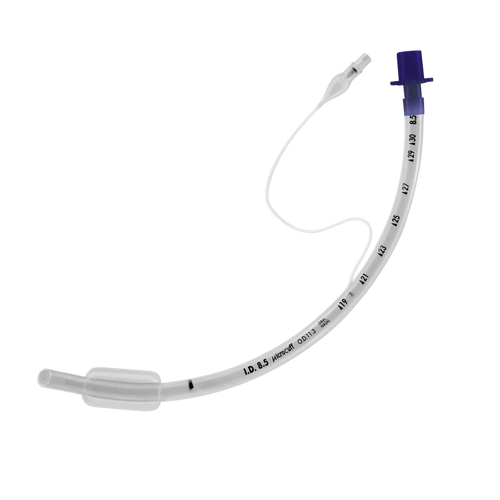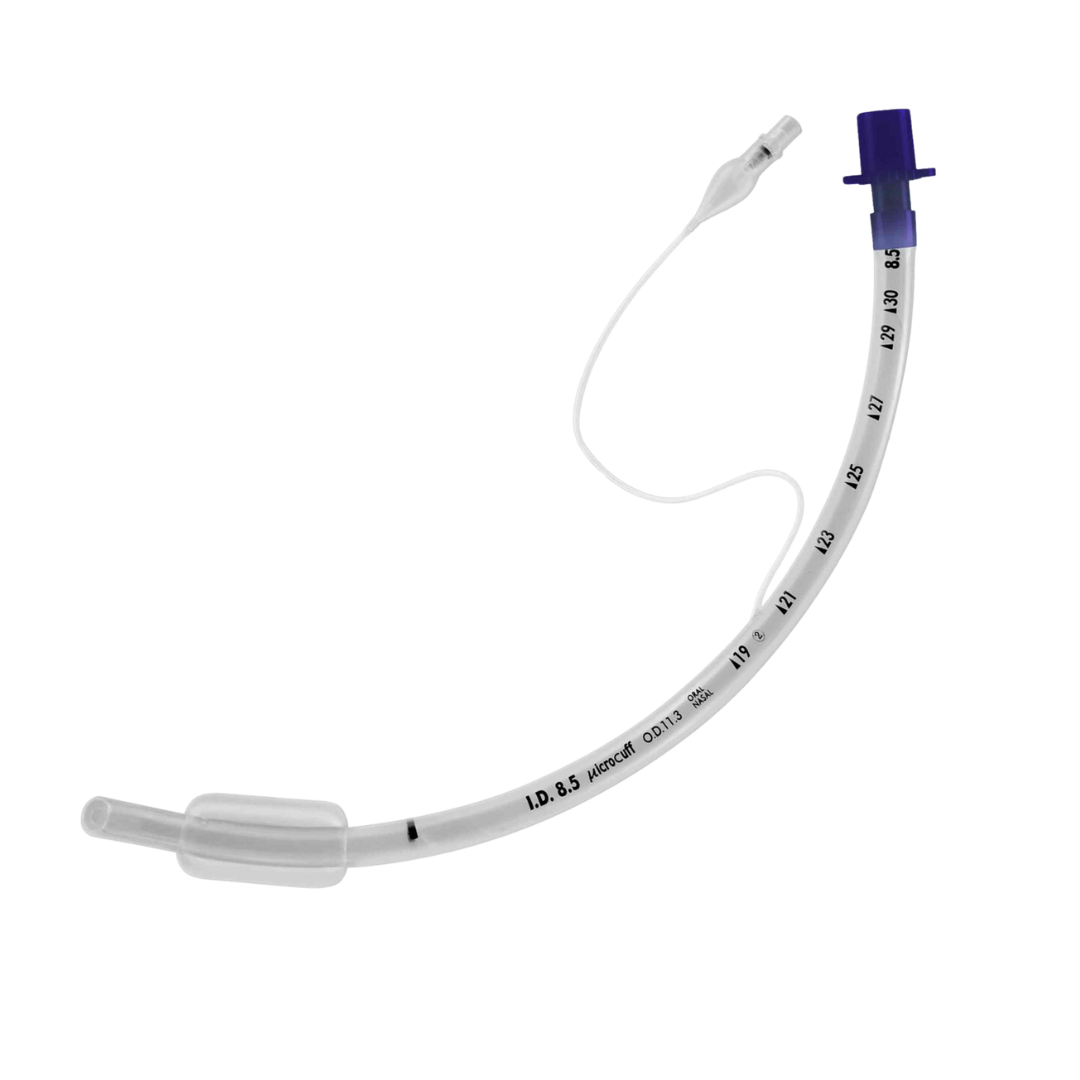Adult Endotracheal Tubes with MICROCUFF® Technology
Advanced adult endotracheal tubes engineered for safety, seal integrity, and reliable airway management across anaesthesia, ICU, and emergency care.
Summary
Airway management is the foundation of critical care, emergency medicine, and perioperative anaesthesia. Adult endotracheal tubes (ETTs) are indispensable tools used to secure the airway, enable mechanical ventilation, and reduce aspiration risk during procedures or respiratory failure. Among the most clinically trusted options available today is the MICROCUFF® Adult Endotracheal Tube, a highly advanced solution offering superior sealing with minimal cuff pressure. This landing page explores adult ET tube sizing, optimal intubation techniques, safety outcomes, and the reasons why MICROCUFF® is considered the gold standard in adult airway management.
Understanding Endotracheal Tube Size for Adults
Correct sizing is a critical determinant of successful intubation and ongoing ventilation. An improperly sized tube may increase the risk of airway trauma, ventilation difficulty, or postoperative complications such as laryngeal injury or subglottic stenosis.
What is “ET Tube Size”?
ET tube size typically refers to the internal diameter (ID) of the tube in millimetres. In adult patients:
- Female adults commonly require 7.0–7.5 mm ID tubes
- Male adults are usually suited to 8.0–8.5 mm ID tubes
- The most common ET tube size for adults is:
Tube size should always be selected in conjunction with:
- Patient anatomy (e.g. tracheal diameter)
- Clinical context (e.g. surgery vs ICU ventilation)
- Imaging or airway exam findings
- Institutional protocol
Studies show that using appropriately sized tubes improves ventilation accuracy and reduces post-extubation complications, particularly when paired with cuff pressure monitoring.
Key Features of MICROCUFF® Adult Endotracheal Tubes
The 10.0mm MICROCUFF® Adult Endotracheal Tube—available in multiple sizes from 6.0 to 10.0 mm—is a high-performance tube trusted globally in surgical theatres and intensive care units. Unlike traditional high-pressure cuffed tubes, MICROCUFF® tubes use an ultra-thin polyurethane cuff, enabling superior tracheal sealing at low pressure.
Clinical Benefits Include:
- Low-pressure, high-volume cuff: Achieves a superior seal without compromising tracheal mucosa integrity.
- Minimised microaspiration: Reduces the risk of ventilator-associated pneumonia (VAP).
- MRI compatibility: Contains no metal components, ensuring diagnostic flexibility.
- Murphy Eye design: Provides a secondary airflow pathway in case of distal tip occlusion.
- Rounded atraumatic tip: Enhances insertion comfort and safety.
- Standardised depth markers: Facilitates accurate placement verification.
MICROCUFF® tubes are also latex-free, DEHP-free, and compliant with ISO safety standards.
Proper Insertion and Monitoring Techniques
Step-by-Step Intubation Protocol:
- Preparation: Choose tube size based on weight/height/gender. Inflate cuff to check for leaks.
- Positioning: Align patient in sniffing position.
- Insertion: Advance ETT under direct laryngoscopy. Confirm placement visually.
- Verification: Confirm tube position via capnography (end-tidal CO₂), bilateral chest auscultation, and chest rise.
- Securing: Fix tube with adhesive device or tie. Note insertion depth.
- Cuff Pressure Monitoring: Maintain between 20–30 cmH₂O. Use manometer to avoid overinflation.
Common Pitfalls to Avoid:
- Over-insertion past carina
- Inadequate cuff pressure
- Tube kinking or occlusion
- Failure to confirm bilateral air entry
Featured Products

When to Use Adult Endotracheal Tubes
ETTs are essential in managing critically ill or unconscious patients across a broad spectrum of clinical situations.
Indications for Adult Intubation:
- General anaesthesia in elective or emergency surgery
- Cardiopulmonary resuscitation (CPR)
- Mechanical ventilation in ICU or high-dependency settings
- Traumatic brain injury or altered mental state
- Severe respiratory distress (e.g. ARDS, COPD exacerbation)
- Protection against aspiration during high-risk procedures
MICROCUFF® Adult ETTs are suitable for both oral and nasal intubation using the Magill technique and are adaptable across anaesthesia machines, ventilators, and transport systems.
Ventilation Compatibility and Best Practices
MICROCUFF® Adult Endotracheal Tubes are compatible with all major ventilation platforms including:
- Philips, GE, and Hamilton ventilators
- Transport ventilators and emergency bag-valve masks (BVMs)
- Anaesthesia gas delivery systems
Best Practice Tips:
- Always use a heat moisture exchanger (HME) to humidify inspired air
- Regularly suction via closed or open systems
- Replace tube if blocked, malpositioned, or visibly damaged
- Monitor for cuff leak signs (e.g. gurgling, low tidal volume, alarm triggers)
Keeping cuff pressures within the safe range significantly reduces mucosal injury and long-term airway complications.
Why MICROCUFF® Over Conventional Cuffed Tubes?
Traditional ETT cuffs often require high inflation pressures to seal the airway, which can lead to ischemia, ulceration, or long-term stenosis. The MICROCUFF® system is engineered to deliver:
- Improved seal at lower pressures
- Lower aspiration rates due to microsealing properties
- No “microchannels” common in older tube models
- Fewer tube changes due to malposition or pressure injury
Clinical trials have shown reduced incidence of ventilator-associated pneumonia (VAP) and sore throat, with faster recovery times in postoperative patients.
Conclusion
Whether used in the operating theatre, ICU, or emergency department, the MICROCUFF® Adult Endotracheal Tube offers the highest level of control, sealing capability, and patient safety. With a comprehensive range of adult ET tube sizes and advanced polyurethane cuff design, it reduces complications, enhances ventilation accuracy, and supports best-practice airway management.
MICROCUFF® isn’t just another tube—it’s a critical upgrade to your respiratory care protocol.
Ready to enhance your airway management protocols?
Shop MICROCUFF® Adult Endotracheal Tubes now and experience unparalleled sealing, patient safety, and clinical control in every intubation.
📞 Call 1300 615 193 or order online at our website.


